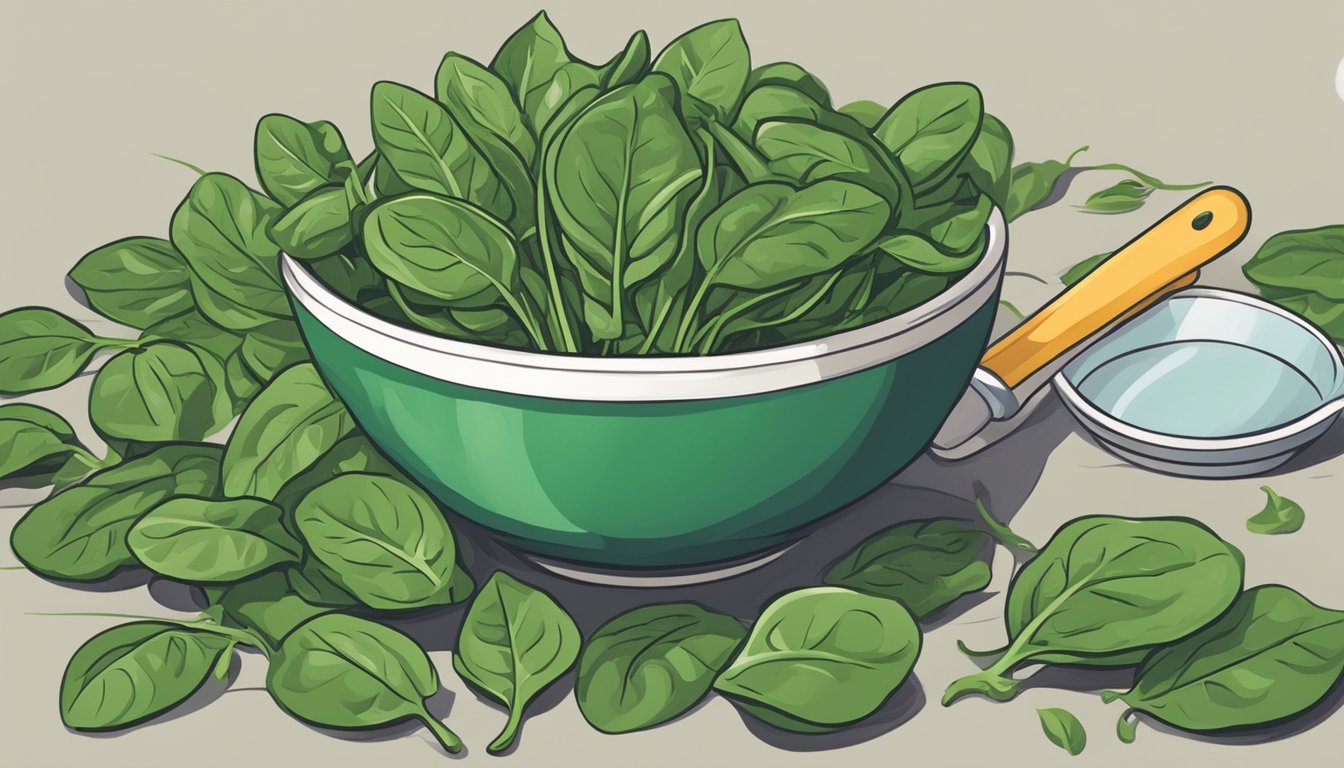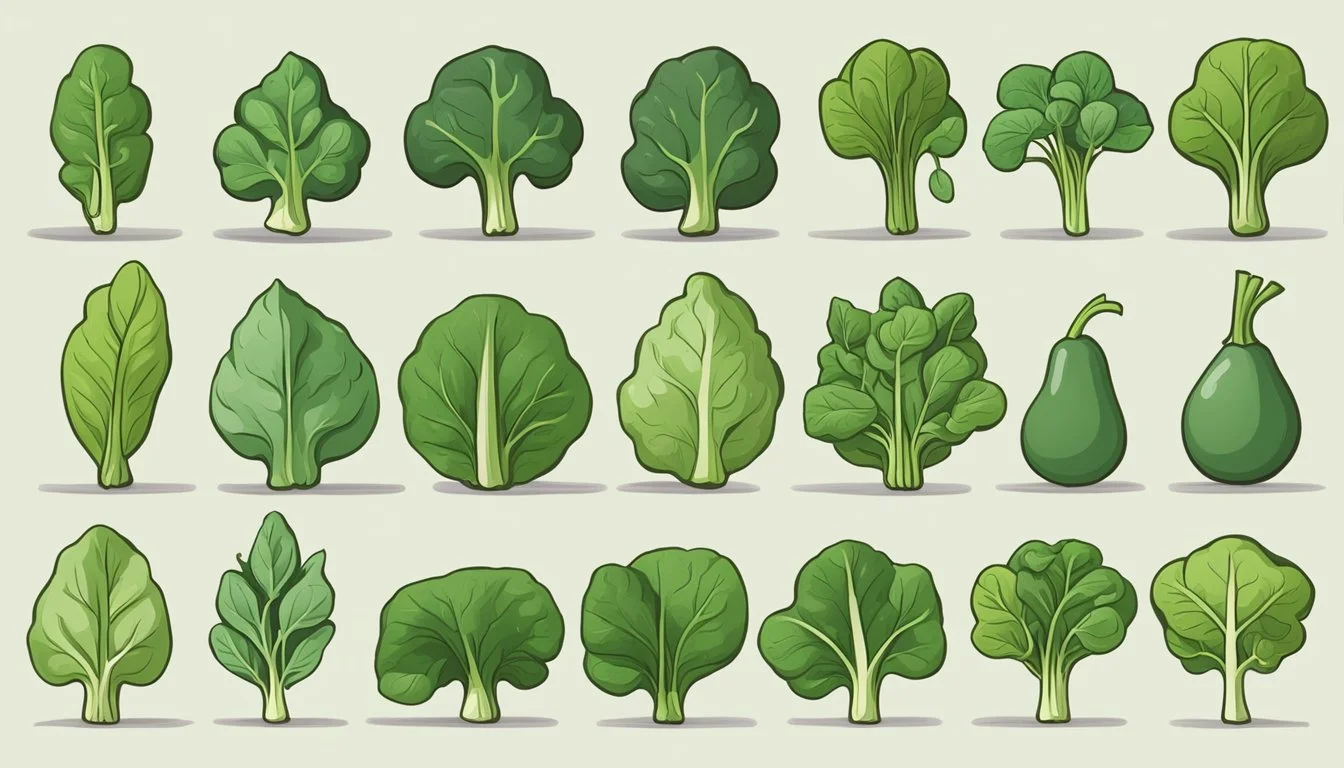How Many Servings of Spinach You Need for Optimal Iron Intake
Spinach (What wine goes well with spinach?) is a nutrient-dense leafy green vegetable that has long been revered for its health benefits, particularly its iron content. It's an essential part of a balanced diet, offering a rich source of vitamins and minerals while being low in calories. As part of a diet for maintaining adequate iron levels, the quantity of spinach consumed plays a crucial role. Iron is a vital mineral essential for creating hemoglobin, a protein that transports oxygen in the blood. While spinach does contain iron, it is of the non-heme type, which is not as readily absorbed by the body as the heme iron found in animal products.
Determining the optimal amount of spinach for iron intake involves understanding how this non-heme iron fits into a person's overall dietary pattern. Spinach also contains vitamin C, which can enhance the absorption of non-heme iron when consumed simultaneously. Individuals looking to boost their iron intake through spinach should factor in both the amount of spinach they consume and the other foods in their diet that could help in maximizing iron absorption.
It is essential to consider the dietary guidelines and individual nutritional needs when incorporating spinach into the diet. While eating spinach can contribute to the daily recommended intake of vegetables, relying solely on spinach for iron can be impractical. Varied dietary sources can ensure a balanced intake of nutrients and prevent potential iron deficiency, especially for those with higher iron requirements, such as premenopausal women. The inclusion of spinach in the diet should be deliberate and in accordance with an individual's specific health goals and dietary requirements.
Nutritional Breakdown of Spinach
Spinach is a nutrient-dense leafy green, packed with a variety of vitamins and minerals while being low in calories.
Vitamins and Minerals Content
Spinach is an excellent source of vitamin K, essential for blood clotting, and vitamin A, important for eye health and immune function. It also contains significant amounts of vitamin C, iron, and magnesium—all vital for maintaining a strong immune system, producing energy, and more. The leafy green is rich in calcium, which is crucial for bone health, potassium for heart health, and folate, important for cell function and tissue growth. Spinach provides smaller amounts of other beneficial nutrients, including vitamin E, manganese, copper, and phosphorus.
Vitamin K: Essential for bone health and blood clotting
Vitamin A: Important for good vision and immune function
Vitamin C: Involved in many body functions including absorption of iron
Iron: Necessary for blood production
Calcium: Vital for bone health and muscle function
Magnesium: Supports muscle and nerve function and energy production
Potassium: Helps regulate fluid balance and blood pressure
Folate: Key for proper brain function and mental and emotional health
Fiber: Promotes digestive health
Caloric Composition
Spinach has a very favorable caloric profile. It is notably low in calories but high in fiber and water content, making it a filling food that is ideal for weight management. Raw spinach contains approximately:
Calories: 23 kcal per 100 grams
Protein: 2.9 g per 100 grams
Carbohydrates: 3.6 g per 100 grams
Sugar: 0.4 g per 100 grams
Fiber: 2.2 g per 100 grams
Fat: 0.4 g per 100 grams
Water: 91% of its weight
The macronutrient profile consists predominantly of carbohydrates and protein, while the fat content is minimal. This makes spinach an ideal ingredient for a nutrient-rich, balanced diet.
Health Benefits of Spinach
Spinach is a nutrient-dense leafy green, known for contributing to various aspects of health including blood and circulation, eye health, bone and muscle strength, and offering cancer-prevention properties due to its antioxidant content.
Blood and Circulation
Spinach is an excellent source of iron, a critical component of hemoglobin, which is essential for transporting oxygen throughout the body. It also contains nitrates that may help to lower blood pressure and improve blood flow. A diet including spinach can support healthy circulation and is beneficial for those with high blood pressure.
Iron Content: A key mineral for blood health.
Nitrates: Assists in managing and preventing high blood pressure.
Eye Health
The antioxidants lutein and zeaxanthin found in spinach play a crucial role in maintaining eye health. They help to filter harmful light waves and may significantly reduce the risk of macular degeneration and cataracts, which are common age-related eye conditions.
Lutein & Zeaxanthin: Support vision and may prevent age-related macular degeneration and cataracts.
Bone and Muscle Strength
Spinach provides important nutrients for bone health such as calcium and magnesium. It also contains vitamin K, which is essential for bone metabolism. Additionally, spinach's protein content helps to maintain muscle strength and facilitates the repair and growth of tissues.
Calcium & Magnesium: Minerals that are vital for bone health.
Vitamin K: An important nutrient for bone metabolism.
Cancer Prevention and Antioxidant Properties
Spinach is high in various antioxidants, including vitamin C, kaempferol, and carotenoids, which help protect the body against free radicals and reduce inflammation. These antioxidants, along with high levels of fiber, may contribute to a reduced risk of certain types of cancer.
Antioxidants: Vitamin C, kaempferol, and carotenoids fight free radicals and may lower cancer risk.
Fiber: Supports the immune system and could have anti-inflammatory benefits.
Impact of Spinach on Specific Health Conditions
Spinach is a powerhouse of nutrients beneficial for managing a variety of health conditions. This section highlights the influence of spinach consumption on diabetes, heart health, digestive health, and the interplay between inflammation and skin.
Diabetes Management
Spinach is loaded with magnesium, a mineral implicated in blood sugar control. Regular intake of spinach can contribute to stable blood sugar levels, making it an ally for those managing diabetes.
Heart Health
The leafy green contains potassium, folate, and antioxidants that support heart health. Potassium helps regulate blood pressure, while folate aids in reducing homocysteine, a known risk factor for heart disease. Additionally, the fiber in spinach assists in lowering cholesterol, another protective factor for the heart.
Digestive Health
Rich in fiber, spinach aids in digestion and can prevent constipation. Its high fiber content promotes a healthy digestive tract, supporting regular bowel movements and maintaining a balanced gut microbiota.
Inflammation and Skin
Spinach contains vitamins A, C, and E, along with antioxidants like lutein, which can help reduce inflammation and maintain skin health. These components collectively protect the skin from oxidative stress and may improve overall skin texture and appearance.
How to Include Spinach in Your Diet
Including spinach in one's diet can significantly contribute to iron intake and overall nutritional value. Spinach can be introduced in various forms—fresh, frozen, or canned—making it versatile for numerous meal options.
Incorporating Spinach into Meals
Spinach, a nutritionally dense leafy green, lends itself well to a variety of meals. One can easily integrate spinach into their diet by:
Breakfast: Adding it to omelettes, scrambles, or smoothies for a morning nutrient boost.
Lunch: Composing salads or sandwiches with raw spinach for crunch and flavor.
Dinner: Enhancing pasta sauces or pizza toppings (What wine goes well with pizza toppings?) with either raw or cooked spinach for an easy addition of greens.
Best Practices for Cooking Spinach
Cooking spinach effectively maximizes its benefits and taste. Key considerations include:
Oils: Sautéing spinach in oils, such as olive oil, infuses it with flavor and aids in the absorption of fat-soluble vitamins.
Garlic: Incorporating garlic not only adds to the palatability but also complements spinach’s natural taste.
Cheese: Pairing spinach with cheeses can make dishes like lasagna or stuffed chicken breast both nutrient-rich and appetizing.
Raw Versus Cooked: Nutrient Absorption
The nutritional profile of spinach alters when it is cooked. It is essential to note the following points:
Raw Spinach: Rich in oxalate, which can inhibit iron absorption; however, consuming raw spinach in salads or smoothies preserves vitamin C and other antioxidants.
Cooked Spinach: Heat reduces oxalate levels, improving iron absorption. Cooking spinach also allows for a greater concentration of certain nutrients, as the leafy green reduces in volume.
Potential Risks and Considerations
While spinach is a nutritious addition to the diet, offering iron, vitamins, and low calories, it is also important for consumers to be aware of its potential risks and considerations, particularly in regard to its oxalate content and its interaction with certain medications.
Effects of Oxalates
Spinach contains a naturally occurring compound known as oxalic acid or oxalates. High intake of oxalates may lead to the formation of kidney stones, particularly in individuals prone to this condition. Oxalates can bind with minerals like calcium and magnesium in the body, reducing their absorption. This is a key consideration for those managing their nutritional intake, especially where mineral deficiencies or kidney health are concerns.
Spinach and Medication Interactions
Individuals taking blood thinners such as warfarin should consume spinach with caution. Spinach is high in Vitamin K, which plays a significant role in blood clotting. Inconsistent intake of Vitamin K can affect the efficacy of warfarin and hence, may impact blood pressure control. Therefore, it's crucial to maintain a consistent level of Vitamin K intake for those on such medications. A healthcare provider can offer personalized advice on managing diet while on blood thinners.
Spinach Varieties and Selection
When choosing spinach, consumers should consider the type and its nutritional profile. It's also important to know how to select and store spinach to maximize freshness and nutrient retention.
Comparing Spinach Types
Spinacia oleracea, the scientific name for spinach, covers several varieties. Each variety offers a distinctive shape, color, and texture, though all are rich in nutrients and antioxidants. Spinach varieties include:
Savoy Spinach: This type has dark green, curly leaves and is often sold fresh in bunches. It has a crisp texture and a hearty flavor.
Flat or Smooth-leaf Spinach: These leaves are unwrinkled and have a flat surface; this type is generally used for canned or frozen spinach and is easier to clean than savoy.
Semi-savoy Spinach: A hybrid with slightly crinkled leaves, it's less difficult to clean than savoy and has a texture that suits both fresh consumption and processing.
Baby Spinach: Young spinach leaves that are smaller and more tender. They are ideal for salads and have become quite popular due to their mild flavor.
In comparison to other leafy greens like kale, spinach typically has softer leaves and cooks more quickly. All varieties are considered a superfood due to their high levels of vitamins, minerals, and antioxidants.
Selection and Storage Tips
Choosing the best quality spinach involves looking for vibrant, fresh leaves. The color of spinach can tell a lot about its quality – bright green hues are preferable. Avoid any bunches with signs of wilting, yellowing, or slimy leaves, as these indicate spoilage. Spinach should be stored in the refrigerator and used within five to seven days to retain its nutrients.
For storage, consider the following tips:
Fresh Spinach: Keep it in a plastic bag in the vegetable crisper of your refrigerator.
Frozen Spinach: Store in the freezer until the expiration date. Once thawed, do not refreeze.
Canned Spinach: It has a longer shelf life but may contain less nutritional value compared to fresh or frozen varieties. Ensure the can is not damaged before purchase.
Regardless of the type, spinach remains a versatile and nutritious leafy green vegetable to include in one's diet.
Conclusion
Eating spinach in moderation can be a healthy addition to most diets, primarily due to its nutrient profile, which includes a good amount of dietary iron. The vegetable is also low in calories and rich in vitamins and minerals, making it beneficial for overall nutritional intake.
As for iron, a serving of 100 grams of raw spinach provides an estimated 2.7 milligrams of iron. While this is a substantial amount for a vegetable, the iron from spinach is non-heme, meaning it's less readily absorbed than the heme iron found in animal products. To enhance absorption, it's advisable to consume spinach with a source of vitamin C.
Daily Iron Requirements and Spinach Intake:
Men aged 19-50: 8 mg/day (3 servings of spinach)
Women aged 19-50: 18 mg/day (7 servings of spinach)
Pregnant Women: 27 mg/day (10 servings of spinach)
It's important to balance spinach intake with other iron-rich foods in the diet, considering the body's needs. Individual requirements may vary based on factors such as age, sex, and physiological conditions, so it is beneficial to consult a healthcare professional about specific nutritional needs.
Incorporating spinach into one's diet can contribute to a variety of health benefits. This leafy green is particularly rich in vitamins A, C, and K, as well as nutrients like folate and potassium. To maximize its health-boosting potential, incorporate spinach into a varied and balanced diet.









